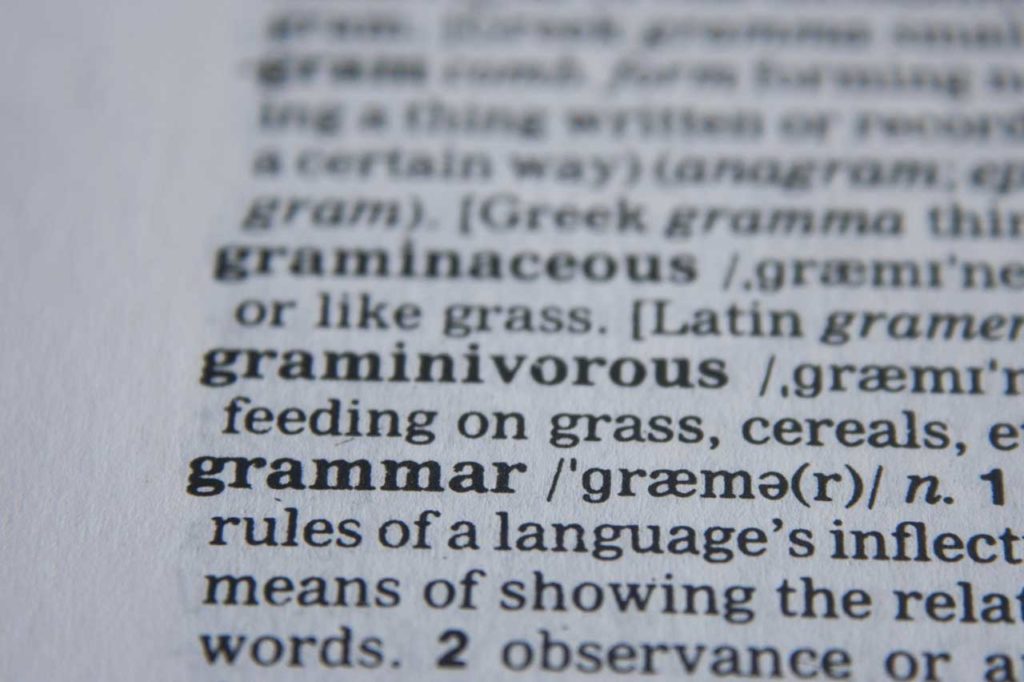
Website grammar in SEO copywriting is crucial to making sure your content appeals to both your customers and search engines. Recent updates to how Google analyses content means that you can no longer rely on your copy mentioning your target keyword throughout. Instead, Google wants quality content, with a good user experience and that your audience stays to read. This is as well as a long list of other SEO factors.
SEO copywriters need to focus on answering questions that customers are asking. This means no more lengthy intros, no keyword stuff and giving clear, accurate information.
Good SEO copywriting = good grammar
Well-written, grammatically correct content is a mark of quality for both readers and Google. In fact, Google’s head of search spam, Matt Cutts outlines the connection between poor spelling and website grammar and lower page rank, saying:
“We noticed a while ago that, if you look at the PageRank of a page — how reputable we think a particular page or site is — the ability to spell correlates relatively well with that. So, the reputable sites tend to spell better and the sites that are lower PageRank, or very low PageRank, tend not to spell as well.”
People notice mistakes. Web pages punctuated with sloppy spelling and poor website grammar lead visitors to question the overall quality and authority of the content. When they do this, they leave. The more visitors bounce out of a site and the less ‘dwell time’ they spend on a page can have a negative impact on your website’s ranking.
Poorly written content is a waste of time

When you forget about website grammar in SEO copywriting, you end up with poorly written content. This is a waste of time for your content marketing strategy as a poorly written page will:
- Contribute towards users losing trust in your brand or business.
- Make information difficult to understand
- Make potential customers work harder to find the information they need.
- Reduce how long a potential customer spends on your site.
According to a study by Global Lingo, 59% of people in the UK would not buy from a website that was full of bad grammar and spelling mistakes. They feel it reflects poorly on the company’s services and makes them look unprofessional.
Grammar in SEO copywriting is incredibly important – for your reputation, your customer experience and every other aspect of your content marketing. You can’t expect good results from your content if your copy is not well written.
Website grammar mistakes SEO copywriters must avoid
A sign of a skilled SEO copywriter is the ability to adopt a friendly, conversational style of writing. However, conversational copy does not mean leaving grammatical errors or even writing how you speak.
The present tense forms
We see the present tense forms mixed up pretty frequently online, on social media and even in printed advertising. So let’s remind ourselves of all of the basics. There are four present tense forms in the English Language:
- Present simple: I work
- Present continuous: I am working
- Present perfect: I have worked
- Present perfect continuous: I have been working.
It may seem pretty straightforward but it’s easy to get them confused and use multiple tenses in a sentence. This simple mistake can change the meaning of your copy.
Overusing adverbs
An adverb is a verb that describes an action and often ends in ‘ly’. For example, “I am quickly writing this sentence”. Adverbs should be used sparingly. When used correctly, an adverb will show, not tell, what is happening in the story.
Your or you’re

The misuse of “your” and “you’re” is a big red flag for relying on a spellchecker to make sure there are no errors in your copy. In fact, if I had a pound for every time I’d seen the misuse of your or you’re in business communications – especially on LinkedIn – I’d be jetting off to a five-star, all-inclusive week in the sun as we speak. Here is how not to use these words:
- Your the best employee.
- Do you know when your going?
- Can I have your email address, please?
- How’s you’re week going?
The same goes with there, their and they’re or two, to and too– simple mistakes that are so noticeable and ones you need to get right.
Using incomplete comparisons
Many words in the English language imply a comparison – and using them without “completing the comparison” is a common grammatical mistake, says Oxford International English School.
For example, here is an incomplete comparison: “I ate so much more today”. To make this sentence grammatically correct, you need to complete the comparison: “I ate so much more today than yesterday.” Making sure your sentences are completed and well written will build you a solid foundation for the success of your content marketing.
Let’s talk about apostrophes

One of the most commonly misused punctuation marks around is the tiny but mighty apostrophe. Here are the basic guidelines on how to use an apostrophe:
- To show possession in place of ‘of’
- To show that a letter is missing. For example: ‘It isn’t’ is the contracted version of ‘it is not’, and ‘let’s’ is the contracted version of ‘let us’.
If an apostrophe is used to show possession by a single person or animal, the apostrophe is placed before the ‘s’. For example, the boy’s toy or the cat’s milk.
If an apostrophe is used to show possession by more than one person or animal then the apostrophe is placed after the ‘s’. For example, the boys’ toys (this relates to the toys of more than one boy) or the firefighters’ hoses (this relates to the hoses of more than one fire fighter).
If the plural noun doesn’t end in ‘s’ then add the apostrophe plus an ‘s’. For example, the women’s changing room (this relates to the changing room belonging to the women) or the children’s toy box (this relates to the toy box belonging to the children).
And finally, here are a few apostrophe checks for terms that SEO copywriters use regularly:
Decades – When referring to decades, such as the 1950s, 1960s etc. the correct way to write them is without an apostrophe. For example, ‘the market has slumped four times since the 1970s’. However, if you omit the 19, then you would write the ‘50s or ‘60s.
Terms and Conditions -‘Terms and Conditions’ is often shortened to T&C’s or T&Cs. Which is correct? There is no possession so it is: T&Cs.
FAQs or FAQ’s – Again, there is no possession, so there is no need for an apostrophe. Both FAQs and FAQ are acceptable
Dos and Don’ts or Do’s and Don’ts: There is no apostrophe after the ‘o’ in Dos, it is Dos and Don’ts.
Dos and Don’ts or Do’s and Don’ts: There is no apostrophe after the ‘o’ in Dos, it is Dos and Don’ts.
How can we help?
Issues surrounding the correct use of website grammar (especially apostrophes) can be complex which is why many publications and organisations have their own editorial guide so that copy is consistent. If you are at all unsure about website grammar use, invest in a style guide or grammar book or consult one of the many resources online – and a good copywriting agency will be able to help you produce this.
Overall, if you want your SEO copywriting to perform well in search, spend time crafting clear, concise, grammatically correct copy that contributes to a good end-user experience for your readers as this will be valued by search engines too.
What are your grammatical bugbears or questions? Let us know below or get in touch.

“Terms and Conditions -‘Terms and Conditions’ is often shortened to T&C’s or T&Cs. Which is correct? There is no possession so it is: T&Cs.”
This has annoyed me for a very long time and I would suggest you’re incorrect.
Given that the words terms and conditions both end in s and both represent a plural, why do you believe terms doesn’t have an s?
I have never understood why so many people use the acronym. I always use Ts&Cs, but know I am fighting a losing battle.
I’m interested in your thoughts.
Yes your version makes a lot of sense but we’re arguing here against erroneous apostrophes in the conventional T&Cs. Let’s campaign for Ts&Cs – I like it!